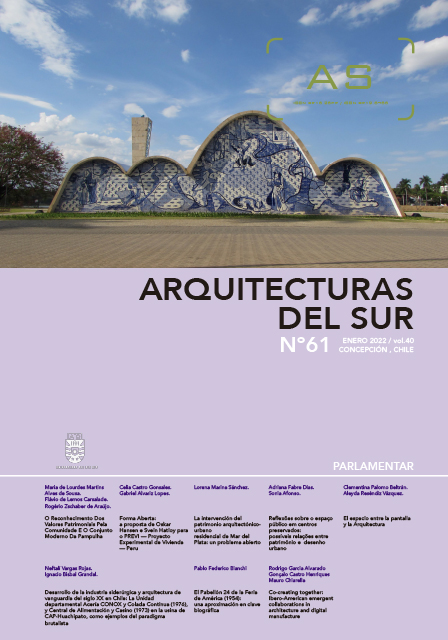Open Form: Oskar Hansen and Svein Hatloy’s proposal for PREVI — Proyecto Experimental de Vivienda — Perú
DOI:
https://doi.org/10.22320/07196466.2022.40.061.02Keywords:
social housing, PREVI, Modernism review, Open Form, flexible housingAbstract
The call for the housing estate of PREVI (Proyecto Experimental de Vivienda – Experimental Housing Project), carried out in 1969, in Lima, happened in a specially fruitful moment of reflections concerning changes in architecture and, mainly, in cities. In this context of criticism, issues like citizen participation and the change in architecture over time became key. This was a process that strongly influenced the proposals of 13 international teams that participated in the call in Peru. This project lab, promoted by the Peruvian government with UN funds, became, according to the opinion of the authors of this article, a fundamental experience in social housing in Latin America in the 20th century, concentrating seminal projects whose ideas still reverberate today. If all international architects who were invited to participate in the call already had, at the time, a significant repertoire in the housing issue, and were greatly in tune with the critical production of their contemporary colleagues, the Polish team, with Oskar Hansen and Svein Hatloy, brought to Peru a very peculiar work experience that they had been developing in Eastern Europe. Two structuring concepts of the practical and theoretical practice of Oskar Hansen and his wife, Zofia Hansen — the ‘Open Form’ and its deployment at an urban scale, the ‘Linear Continuous System’ (LCS) — appear in the proposal for PREVI as instruments for the search of a flexible architecture in space and time, open to citizen participation and intervention and adequate to their sociocultural peculiarities. Therefore, the present article aims at rescuing, through a more specific outline, the guiding ideas of the Polish proposal for the call and, in a broader sense, raising the importance of PREVI as a fundamental reference for social housing projects nowadays.
Downloads
References
FRAMPTON, K. (2015). Preface. In P. Land, The experimental housing Project (PREVI), Lima. Design and Technology in a new neighborhood (pp. 19-21). Universidad de los Andes.
GONSALES, C., & BERTINETTI, G. (2019). O projeto de habitação e de cidade de Candilis, Josic e Woods para a América do Sul: Proyecto Experimental de Vivienda-Previ, Peru. OCULUM ENSAIOS, 16(3), 481-501. https://doi.org/10.24220/2318-0919v16n3a4279
HANSEN, O. (1958, Listopad). Studium i realizacja mieszkania. Architektura (11), 433-440. https://bit.ly/3l9dEBR
HANSEN, O. (1969). Proposition pour un système d'urbanisme linéaire. Le Carré Bleu (2). https://bit.ly/3FrWN5t
HANSEN, O., & HANSEN, Z. (1959). The Open Form in architecture: The art of the great number [Apresentação em Congresso]. CIAM ‘59, Otterlo, Países Baixos. https://bit.ly/3A4kMna
HANZEN, Z. (s.d.). Joanna Mytkowska rozmawia w Szuminie z Zofią Hansen [Entrevista a Joanna Mytkowska]. https://bit.ly/3BdLZVP
ININVI & Ministerio De Vivienda. (1971). PREVI PP1: I-10: Vol. 18. Lima: Ministerio de Vivienda y Construcción del Perú.
KEDZIOREK, A., & STANEK, L. (2012). Architecture as a pedagogical object: What to preserve of the Przyczolek Grochowski Housing Estate by Oskar & Zofia Hansen in Warsaw?. Architektúra & urbanizmus, 46(3-4), 250-269. https://bit.ly/3uFR8DI
KWIATKOWSKI, K. (2019, November). Applications of Linear Systems in Contemporary Urban Design. In IOP Conference Series: Earth and Environmental Science, 362 (1), 012170. https://bit.ly/2WDUVoo
MELO, V. P. DE (2016). A obra de arte aberta e os processos de interatividade. Revista Interdisciplinar Internacional de Artes Visuais-Art&Sensorium, 3 (1), 51-61. https://bit.ly/3uNcr6s
LAND, P. (2008). El Proyecto Experimental de Vivienda (PREVI) de Lima: antecedentes e ideas. In F. G. Huidobro, D. Torres, & N. Tugas, ¡El tiempo construye! / Time Builds! (pp. 10-25). Gustavo Gili.
LAND, P. (2015). The experimental housing Project (PREVI), Lima. Design and Technology in a new neighborhood. Universidad de los Andes.
LÓPEZ-MARCOS, M. (2015). Anti-ciudad como infraestructura. El sistema lineal continuo de Oskar Hansen. Proyecto, Progreso, Arquitectura, 13, 45-57. https://bit.ly/3D8bNmX
LUCAS ALONSO, P. (2015). El concurso del tiempo. Las viviendas progresivas del PREVI-Lima. [Tesis doctoral, Universidad Politécnica de Madrid]. https://bit.ly/3a5jCgz
PREVI/Lima: low cost housing project. (1970, April). Architectural Design, 40(4), 187-205.
RUIZ ALONSO, J. J. (2018). Oskar Hansen y la forma abierta: influencias e interrelaciones en el desarrollo del arte contemporáneo. Museo Patio Herreriano de Arte Contemporáneo Español. https://bit.ly/3A9UkbQ
SPRINGER, F. (2017). Zlé urodzone: reportaże o architekturze PRL-u. Karakter.
STANEK, L. (2014). Oskar and Zofia Hansen: Me, You, Us and the State. In L. Stanek (Ed.), Team 10 East: revisionist architecture in real existing modernism (pp. 210-241). Museum of Modern Art in Warsaw. https://bit.ly/3Fs17ld
Downloads
Published
How to Cite
Issue
Section
License
Copyright (c) 2022 Celia Castro-Gonsales, GabrielGabriel Alvariz-Lopes

This work is licensed under a Creative Commons Attribution-ShareAlike 4.0 International License.
The content of the articles published in each issue of Arquitecturas del Sur is the sole responsibility of the authors and does not necessarily represent the opinion of University of the Bío-Bío.
The authors will maintain their copyright; however, they will guarantee the journal the right to first publication and dissemination of their work. The publication of the article in Arquitecturas del Sur will be subject to the Creative Commons International license (CC BY-SA) that allows others to adapt: remix, transform and build on the material for any purpose, even commercially; share: copy and redistribute the material in any medium or format, as long as the authorship and first publication in this journal are acknowledged by citing them correctly, and their new contributions are under a license with the same terms.














 Programa de Información Científica/Concurso Fondos de Publicación de Revistas Científicas 2018/ Proyecto Mejoramiento de Visibilidad de Revistas UBB (Código:FP180007)
Programa de Información Científica/Concurso Fondos de Publicación de Revistas Científicas 2018/ Proyecto Mejoramiento de Visibilidad de Revistas UBB (Código:FP180007) 
